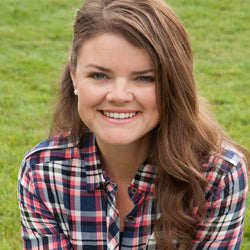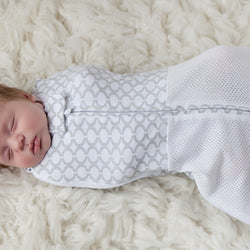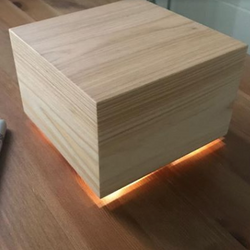What Are Baby Sleep Cues and How to Identify Them

by Valerie Plowman
Apr 12, 2018
Healthy sleep is vital to the growth and health of a baby; it is also invaluable to the mental health and productivity of the caretaker. The best way to get the best naps is to pay attention to sleep cues. Baby sleep cues are signs your baby gives that he/she is ready for sleep.
When the average person thinks of signs of sleepiness, they think of a lot of yawning, rubbing of eyes, and getting droopy-eyed. We may picture a person starting to nod off. Unfortunately, a baby's sleep cues are not limited to that simple list.
Sleep cues are more complicated than that
There is a long list of many potential sleep cues. What is a sleep cue for one baby is insignificant for the next. To make things even more interesting and complicated, your baby's sleep cues can change over time, so the definite sleep cues from a month ago can lead you astray today. You may even find your baby has no discernible cues. Let's discuss common sleep cues:
Article Continues Below Advertisement
Common Baby Sleep Cues
Below is a list of common sleep cues babies display:
- Yawning
- Decreased activity--baby will stop moving around and stare off
- Slower motions
- Less vocal
- Less interactive
- Sucking is weaker or slower
- Quieter
- Calmer
- Appears disinterested
- Eyes less focused
- Red around the eyes
- Rubbing eyes
- Eyelids drooping
- Less social (smiling less and a lack of engaging you)
- Fussiness
- Hard to distract and keep happy
- Disobeying (this is for older babies/toddlers/preschoolers)
- Time awake (this is a very helpful "cue" for a Babywise mom following a schedule)
Too Late Baby Sleep Cues
Some of the above cues are helpful to show you that baby is ready for a nap. Some of them might mean "oops...this waketime was too long. Baby should have gone down sooner" for your baby. Below are some cues that for most babies mean you let waketime length go on too long:
- Fussiness/crankiness/irritability: Many people erroneously wait for a baby to be very fussy before considering that baby might be tired and ready for a nap. Extreme fussiness is typically a sign that baby is way over tired and you missed the ideal time to put baby down for a nap. Some babies might have some minor fussiness as a legitimate cue, which is why it is included in the list above, but most of the time for most babies, fussiness actually means "too late."
- Eye rubbing or drooping: If your baby is rubbing his/her eyes, it is probably beyond the ideal time to start nap time. Also, once you are beyond the super-sleepy newborn stage, eye-drooping is akin to fussiness. Baby needed to be in that crib sooner.
How to Identify Your Baby's Sleep Cues
Now that you have a nice master list of possible sleep cues and what is a too-late cue, let's discuss how you can tell what is a sleep cue for your baby:
- Pay close attention to baby: The first thing you need to do is pay close attention to your baby. What is your baby's individual behavior pattern during awake time? Most babies will play and be interactive and then start to drift from being active toward stillness. After stillness comes fussiness. Note the things from the list your baby does, then decide which cue might be the best indicator that baby is ready for a nap. Some babies might be at the first yawn, while others are at the third yawn. For others, the yawn means nothing. Take note of which cues your baby displays and then make a guess at what might be your baby's cue.
- Know common optimal waketime lengths for your baby's age: You want to couple your baby's sleep cue list with the common optimal waketime length for babies. Most babies will fit into a tight range of how long he/she should be awake before the next nap should start. Be aware of what is normal and judge baby's sleep cues in the context of time range. Remember that waketime length includes feeding time.
- Take notes: You cannot trust your memory in these days of problem solving. I can't tell you how many times I thought something was the best sleep cue when reflecting on my memory of it, but when I analyzed my notes, I realized I was off. Take notes of sleep cues and waketime length. Note the cues displayed, how long baby was awake, and how the nap went.
- Apply the scientific method: Now that you know what to look for and about how long baby should be awake, you are prepared to take notes and apply the scientific method to figure out sleep cues. I promise this is easier than it might seem. You know your question--what are my baby's sleep cues? You have done your research by reading this and other linked posts. Next you make a guess. Based on what you have observed so far, what do you guess baby's sleep cues to be? For the next few naps, try starting nap after you see that/those cues. Take notes in your logs. Note what cues you used and how the nap went. If things are going well, stick with it. If they aren't, decide what to tweak. Continue tweaking until you get it right.
- Adjust as needed: My babies changed sleep cues as they got older. Sometimes they even had periods of no cue at all and I had to go completely off waketime length. I had to adjust what cues I went by as they got older. Be sure you adjust as baby changes.
Baby Sleep Cues Conclusion
As you work on the sleep cues, have patience with yourself. There will be naps you make a guess as to what the best sleep cue is and you get it way wrong. Forgive yourself. You are only human and doing your best. Keep working at it and things will become more natural for you. You will get to know each of your babies better as individuals and know how to respond to their distinct needs. Sleep cues are a great starting point for achieving great naps. The effort can be exhausting and frustrating at times, but the effort is well worth it.
Article Continues Below Advertisement
Valerie Plowman
Valerie Plowman is a Babywise Mom of four children and blogs at www.BabyWiseMom.com. Read her latest book, The Babywise Mom Nap Guide, for help on getting perfect naps.










